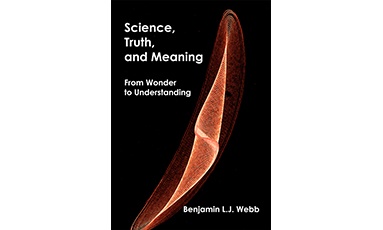Bókin sýnir vísindalega og heimspekilega athugun á stöðu okkar í heiminum. Hún sýnir þá ferð sem mannkynið hefur farið frá heimspekilegri rannsókn fyrstu Grikkja til þess hvernig vísindi hafa haft djúpstæð áhrif á hugmynd okkar um tilveruna.
"Vísindi, Sannleikur og merking' er yfirskriftin á þessu bók because it presents a scientific and philosophical examination of our place in the world. It celebrates the diverse, interconnected, scientific knowledge that mankind has constructed, and describes how it is reducible to a shared foundation. The book explores scientific truth, and confronts whether truth is absolute or relative to who and what we are. It reveals the journey mankind has made from the philosophical enquiry of the early Greeks to how science has profoundly influenced our conception of existence.
The first chapter is entitled ‘Philosophy and science: Paving the way to modern science’, and discusses how questions about the workings of the Universe were once the domain of philosophers, and that that this led to modern science, and scientific method, which became our proven method of determining useable truths about physical reality. The application of scientific method through integrated disciplines utilising a common set of expanding proven principles and rules, enabled us to start to delineate the processes of the Universe. Yet, since science is constrained by the rules governing the interaction of force and matter, philosophical enquiry has, and continues to, enable us to probe possibilities limited only by the creativity of the mind. Hence, philosophy is can be a guide as to what might be, whereas science uses this to determine what is.
Chapters 2 and 3 address the physical world as described by classical and quantum theories. The development and details of these two models encapsulate our current understanding of the fundamental nature of physical reality. Classical, and the later quantum, physics describe with incredible accuracy the behaviour of the largest and smallest objects in the Universe, respectively. Yet, primarily, they are incompatible and conflicting theories. Classical physics defines the processes of the very large (such as vetrarbrautir) acting over huge expanses of space and time, whereas quantum theory explains the behaviour of the very small (such as subatomic particles). To unite these two independently accurate descriptions into one grand theory of everything is the holy grail of science.
Kafli 4 og 5 fjallar um líffræðilega heiminn - hvað við erum og hvernig við urðum til. Þó að kenningar fyrri kafla liggi til grundvallar því hvernig kraftur og efni hafa samskipti til að framleiða líkamleg fyrirbæri, lýsa þær ekki því hvernig menn skilja alla stórsæja hegðun, og fyrst og fremst ekki lífvera. Þessi kafli fjallar bæði um eðlisfræðilega aðferðir sem gera lifandi veru kleift að lifa og hvernig lífverur og tegundir þróast yfir margar milljónir ára.
Eftir að hafa metið hvað við erum, hvernig við urðum til, hvert er rýmið sem við erum í og hvernig er það byggt upp, getum við snúið okkur í hring og endurskoðað grundvallarspurningar heimspekinga fyrsta kaflans. Kafli 6 og 7 snúast því um hvað „hugur“ er og hvernig hann hefur samskipti við heiminn. Leit mannsins að merkingu með því að nota ramma vísindanna sem grunn leiðir í ljós að þó hægt sé að svara nokkrum spurningum um tilveru okkar, þá bætir viðbætt þekking við nýjum vandamálum sem ekki komu fram áður. Við komumst að þeirri niðurstöðu að það sé margt sem við vitum ekki enn og vitum kannski aldrei. Reyndar finnum við að sannleikur er afstætt hugtak en ekki algert.
The difficulties in obtaining the truth we seek about our place in the Universe are linked not only to our understanding of many concepts, such consciousness, free will, and determinism, but also the very limitations on our mental capacity imposed on us by reality itself. Yet, in finding that certain questions cannot be answered, a firmer grounding of what is possible for a human mind to understand enables us to focus of what is important and achievable.
***
UM HÖFUNDINN
Benjamin LJ Webb
Dr. Webb er lífefnafræðingur og sameindalíffræðingur að mennt, með sérfræðiþekkingu fyrst og fremst í veirufræði og krabbameinsrannsóknum, bæði í akademíunni og nú í líftækniiðnaðinum. Doktorspróf hans hlaut við Imperial College í London og síðan komu rannsóknarstörf við stofnanir eins og University College London og Cancer Research UK. Áhugi hans á efninu sem fjallað er um í þessari bók hófst sem persónulegt rannsóknarferðalag fyrir 20 árum, með það að markmiði að öðlast víðtækari skilning á því hversu nákvæmlega vísindi geta útskýrt líkamlegan veruleika. Þessar rannsóknir náðu hámarki í þessari bók.
Skoðanir og skoðanir sem koma fram í bloggum eru eingöngu skoðanir höfundar og annarra þátttakenda, ef einhver er.






































